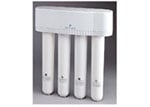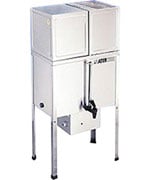Many harmful chemicals are widely used in local business and industry. Other chemicals are generated by households and find their way into groundwater by leaking septic tanks.The most common sources of such problems are:
- Local Businesses: These include nearby factories, industrial plants, and even small businesses such as gas stations and dry cleaners. All handle a variety of hazardous chemicals that need careful management. Spills and improper disposal of these chemicals or of industrial wastes can threaten ground water supplies.
- Leaking Underground Tanks & Piping: Petroleum products, chemicals, and wastes stored in underground storage tanks and pipes may end up in the ground water. Tanks and piping leak if they are constructed or installed improperly. Steel tanks and piping corrode with age. Tanks are often found on farms. The possibility of leaking tanks is great on old, abandoned farm sites. Farm tanks are exempt from the EPA rules for petroleum and chemical tanks.
- Landfills and Waste Dumps: Modern landfills are designed to contain any leaking liquids. But floods can carry them over the barriers. Older dumpsites may have a wide variety of pollutants that can seep into ground water.
- Household Wastes: Improper disposal of many common products can pollute ground water. These include cleaning solvents, used motor oil, paints, and paint thinners. Even soaps and detergents can harm drinking water. These are often a problem from faulty septic tanks and septic leaching fields.
In order to make claims for removal of chemicals, a water treatment device should be certifed by the the National Sanitation Foundation, also known as NSF. The only systems we carry that are NSF certified for “chemical” contaminants are drinking water point-of-use systems.
We can supply non-certified whole house or larger flow chemical removal systems if you know the specific contaminant you are trying to remove, on a case by case basis, and your application does not require a State certified or NSF certified system. The regulations vary by country and by state or provinces in individual countries.
Need help selecting a system? Fill out our quick and easy Water System Designer Form and get a response in 24 hours or less.
The United States Environmental Protection Agency (USEPA) set standards for certain contaminants in drinking water:
- Maximum Contaminant Level Goal (MCLG) – refers to the level of a contaminant in drinking water below which there is no known or expected risk to health. MCLGs allow for a margin of safety and are non-enforceable public health goals.
- Maximum Contaminant Level (MCL) – This is the highest level of a contaminant that is allowed in drinking water. MCLs are set as close to MCLGs as feasible using the best available treatment technology and taking cost into consideration. MCLs are enforceable standards
Organic Chemicals
| Contaminant | MCLG (mg/L) |
MCL (mg/L) |
Potential Health Effects from Ingestion of Water | Sources of Contaminant in Drinking Water |
| Acrylamide | zero | TT9 | Nervous system or blood problems; increased risk of cancer | Added to water during sewage/wastewater treatment |
| Alachlor | zero | 0.002 | Eye, liver, kidney or spleen problems; anemia; increased risk of cancer | Runoff from herbicide used on row crops |
| Atrazine | 0.003 | 0.003 | Cardiovascular system or reproductive problems | Runoff from herbicide used on row crops |
| Benzene | zero | 0.005 | Anemia; decrease in blood platelets; increased risk of cancer | Discharge from factories; leaching from gas storage tanks and landfills |
| Benzo(a)pyrene (PAHs) | zero | 0.0002 | Reproductive difficulties; increased risk of cancer | Leaching from linings of water storage tanks and distribution lines |
| Carbofuran | 0.04 | 0.04 | Problems with blood, nervous system, or reproductive system | Leaching of soil fumigant used on rice and alfalfa |
| Carbon tetrachloride | zero | 0.005 | Liver problems; increased risk of cancer | Discharge from chemical plants and other industrial activities |
| Chlordane | zero | 0.002 | Liver or nervous system problems; increased risk of cancer | Residue of banned termiticide |
| Chlorobenzene | 0.1 | 0.1 | Liver or kidney problems | Discharge from chemical and agricultural chemical factories |
| 2,4-D | 0.07 | 0.07 | Kidney, liver, or adrenal gland problems | Runoff from herbicide used on row crops |
| Dalapon | 0.2 | 0.2 | Minor kidney changes | Runoff from herbicide used on rights of way |
| 1,2-Dibromo-3-chloropropane (DBCP) | zero | 0.0002 | Reproductive difficulties; increased risk of cancer | Runoff/leaching from soil fumigant used on soybeans, cotton, pineapples, and orchards |
| o-Dichlorobenzene | 0.6 | 0.6 | Liver, kidney, or circulatory system problems | Discharge from industrial chemical factories |
| p-Dichlorobenzene | 0.075 | 0.075 | Anemia; liver, kidney or spleen damage; changes in blood | Discharge from industrial chemical factories |
| 1,2-Dichloroethane | zero | 0.005 | Increased risk of cancer | Discharge from industrial chemical factories |
| 1,1-Dichloroethylene | 0.007 | 0.007 | Liver problems | Discharge from industrial chemical factories |
| cis-1,2-Dichloroethylene | 0.07 | 0.07 | Liver problems | Discharge from industrial chemical factories |
| trans-1,2-Dichloroethylene | 0.1 | 0.1 | Liver problems | Discharge from industrial chemical factories |
| Dichloromethane | zero | 0.005 | Liver problems; increased risk of cancer | Discharge from drug and chemical factories |
| 1,2-Dichloropropane | zero | 0.005 | Increased risk of cancer | Discharge from industrial chemical factories |
| Di(2-ethylhexyl) adipate | 0.4 | 0.4 | Weight loss, liver problems, or possible reproductive difficulties. | Discharge from chemical factories |
| Di(2-ethylhexyl) phthalate | zero | 0.006 | Reproductive difficulties; liver problems; increased risk of cancer | Discharge from rubber and chemical factories |
| Dinoseb | 0.007 | 0.007 | Reproductive difficulties | Runoff from herbicide used on soybeans and vegetables |
| Dioxin (2,3,7,8-TCDD) | zero | 0.00000003 | Reproductive difficulties; increased risk of cancer | Emissions from waste incineration and other combustion; discharge from chemical factories |
| Diquat | 0.02 | 0.02 | Cataracts | Runoff from herbicide use |
| Endothall | 0.1 | 0.1 | Stomach and intestinal problems | Runoff from herbicide use |
| Endrin | 0.002 | 0.002 | Increased cancer risk, and over a long period of time, stomach problems | Discharge from industrial chemical factories; an impurity of some water treatment chemicals |
| Ethylbenzene | 0.7 | 0.7 | Liver or kidneys problems | Discharge from petroleum refineries |
| Ethylene dibromide | zero | 0.00005 | Problems with liver, stomach, reproductive system, or kidneys; increased risk of cancer | Discharge from petroleum refineries |
| Glyphosate | 0.7 | 0.7 | Kidney problems; reproductive difficulties | Runoff from herbicide use |
| Heptachlor | zero | 0.0004 | Liver damage; increased risk of cancer | Residue of banned termiticide |
| Heptachlor epoxide | zero | 0.0002 | Liver damage; increased risk of cancer | Breakdown of heptachlor |
| Hexachlorobenzene | zero | 0.001 | Liver or kidney problems; reproductive difficulties; increased risk of cancer | Discharge from metal refineries and agricultural chemical factories |
| Hexachlorocyclopentadiene | 0.05 | 0.05 | Kidney or stomach problems | Discharge from chemical factories |
| Lindane | 0.0002 | 0.0002 | Liver or kidney problems | Runoff/leaching from insecticide used on cattle, lumber, gardens |
| Methoxychlor | 0.04 | 0.04 | Reproductive difficulties | Runoff/leaching from insecticide used on fruits, vegetables, alfalfa, livestock |
| Oxamyl (Vydate) | 0.2 | 0.2 | Slight nervous system effects | Runoff/leaching from insecticide used on apples, potatoes, and tomatoes |
| Polychlorinated biphenyls (PCBs) | zero | 0.0005 | Skin changes; thymus gland problems; immune deficiencies; reproductive or nervous system difficulties; increased risk of cancer | Runoff from landfills; discharge of waste chemicals |
| Pentachlorophenol | zero | 0.001 | Liver or kidney problems; increased cancer risk | Discharge from wood preserving factories |
| Picloram | 0.5 | 0.5 | Liver problems | Herbicide runoff |
| Simazine | 0.004 | 0.004 | Problems with blood | Herbicide runoff |
| Styrene | 0.1 | 0.1 | Liver, kidney, or circulatory system problems | Discharge from rubber and plastic factories; leaching from landfills |
| Tetrachloroethylene | zero | 0.005 | Liver problems; increased risk of cancer | Discharge from factories and dry cleaners |
| Toluene | 1 | 1 | Nervous system, kidney, or liver problems | Discharge from petroleum factories |
| Toxaphene | zero | 0.003 | Kidney, liver, or thyroid problems; increased risk of cancer | Runoff/leaching from insecticide used on cotton and cattle |
| 2,4,5-TP (Silvex) | 0.05 | 0.05 | Liver problems | Residue of banned herbicide |
| 1,2,4-Trichlorobenzee | 0.07 | 0.07 | Changes in adrenal glands | Discharge from textile finishing factories |
| 1,1,1-Trichloroethane | 0.20 | 0.20 | Liver, nervous system, or circulatory problems | Discharge from metal degreasing sites and other factories |
| 1,1,2-Trichloroethane | 0.003 | 0.005 | Liver, kidney, or immune system problems | Discharge from industrial chemical factories |
| Trichloroethylene | zero | 0.005 | Liver problems; increased risk of cancer | Discharge from metal degreasing sites and other factories |
| Vinyl chloride | zero | 0.002 | Increased risk of cancer | Leaching from PVC pipes; discharge from plastic factories |
| Xylenes (total) | 10 | 10 | Nervous system damage | Discharge from petroleum factories; discharge from chemical factories |








